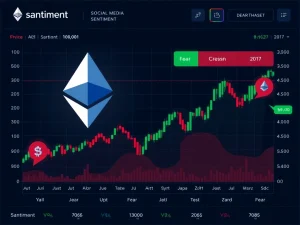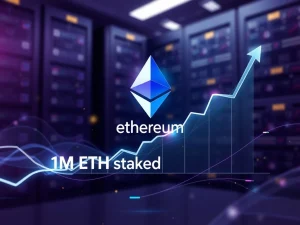LISTA’s Astounding 14.7% Surge: Unpacking Crypto Volatility and Speculative Trading

The cryptocurrency market is a wild ride, and if you’re a crypto enthusiast, you’ve likely seen your fair share of sudden price movements. Recently, LISTA captured headlines with an astounding 14.7% surge in just 24 hours. But here’s the kicker: this significant jump occurred without any clear, discernible market catalysts. What exactly is driving such rapid price action in the absence of fundamental news? Let’s dive deep into this fascinating case of market dynamics.
LISTA Surge: A Closer Look at the 14.7% Jump
According to the latest HTX market data, LISTA’s price rapidly climbed to $0.35 within a 24-hour window, marking a substantial 14.7% increase before settling slightly to $0.3358. This impressive LISTA surge immediately grabbed attention, particularly given the broader context of global financial markets. While the Osaka Nikkei 225 Next Index saw a significant rise around the same time, analysts were quick to note that no direct link between the traditional equity market’s performance and LISTA’s digital asset movement was established.
This rapid price ascent highlights the inherent volatility often seen in the crypto space. Without any explicit news from the LISTA project team, or significant shifts in regulatory frameworks, the surge points towards market forces unique to digital assets.
Unpacking the Dynamics of Crypto Volatility
The cryptocurrency market is renowned for its extreme price swings, and LISTA’s recent performance is a classic example of this characteristic crypto volatility. Unlike traditional assets that often react to company earnings, economic reports, or geopolitical events, many digital assets can experience dramatic shifts based on factors less apparent to the casual observer.
Several elements contribute to this:
- Lower Liquidity: Compared to established financial markets, many altcoins have smaller market caps and lower trading volumes, making them more susceptible to large price movements from relatively small trades.
- Sentiment-Driven: Crypto markets are heavily influenced by community sentiment, social media trends, and ‘fear of missing out’ (FOMO), which can trigger rapid buying frenzies.
- Whale Activity: Large holders (whales) can significantly impact prices with substantial buy or sell orders.
The absence of fundamental news supporting the LISTA surge suggests that these more speculative elements were likely at play.
Is This Pure Speculative Trading?
When an asset’s price rockets without any underlying news, it often signals a wave of speculative trading. This involves investors buying an asset primarily based on the expectation that its price will rise in the short term, allowing them to sell for a quick profit, rather than on its long-term value or fundamental utility. The LISTA case appears to fit this pattern.
The market data indicates that liquidity shifts and short-term trading dynamics were the primary drivers. Interestingly, Binance Square also highlighted a similar 14% surge in $TIA around the same period, underscoring a broader trend of rapid, often unexplained, price fluctuations within the altcoin sector. While the timing was close, the distinct nature of each asset suggests independent market forces, rather than a coordinated sector-wide rally.
What are the implications for investors?
For those considering engaging with such volatile assets, it’s crucial to:
- Exercise Caution: Unexplained surges carry significant risk of rapid corrections.
- Monitor Volume: A surge without corresponding significant trading volume often indicates limited market participation, making the price movement less sustainable.
- Avoid FOMO: Chasing pumps can lead to losses if the price quickly reverses.
The Broader Digital Asset Landscape: What Does This Mean?
LISTA’s surge serves as a powerful reminder of the unique characteristics of the digital asset market. Unlike traditional stocks or commodities, cryptocurrencies operate in a relatively nascent and less regulated environment. This allows for greater freedom but also introduces higher levels of risk and unpredictability.
While some might view such surges as opportunities, experienced traders often approach them with skepticism if they lack fundamental backing. The fact that the surge has not been accompanied by significant changes in on-chain activity (like increased network usage or transaction counts) or institutional involvement further reinforces the idea that this was likely a retail-driven, short-term event.
Searching for Market Catalysts: Why the Silence?
Perhaps the most perplexing aspect of LISTA’s recent rally is the complete absence of clear market catalysts. Typically, a price increase of this magnitude would be tied to:
- Project Updates: New partnerships, product launches, or technological advancements.
- Exchange Listings: Getting listed on a major exchange can significantly boost liquidity and exposure.
- Regulatory News: Favorable legislation or clarity can instill investor confidence.
- Macroeconomic Factors: Broader economic trends that might drive investment into riskier assets.
In LISTA’s case, none of these factors were cited. The source material explicitly states that the Osaka Nikkei 225 Next Index’s rise was attributed to broader equity market trends and was unrelated to LISTA’s performance, despite sharing a reporting date.
The silence from the LISTA project team or ecosystem partners further leaves the rationale for the rally open to interpretation. This lack of transparency makes it challenging for investors to assess the sustainability of the price movement, urging them to rely heavily on technical analysis and risk management strategies.
Conclusion: Navigating the Unpredictable Crypto Seas
LISTA’s sudden 14.7% surge without clear catalysts is a textbook example of the unpredictable nature of the cryptocurrency market. It underscores how easily prices can be swayed by speculative trading and short-term liquidity shifts, rather than fundamental value or verifiable news. While such rapid gains can be enticing, they come with significant risks, reminding investors that due diligence and a cautious approach are paramount.
As the crypto landscape continues to evolve, understanding the difference between fundamentally driven growth and speculation-fueled pumps becomes increasingly critical. For LISTA, only time and subsequent trading patterns will reveal if this surge was a fleeting moment of volatility or a precursor to more sustained interest.
Frequently Asked Questions (FAQs)
1. What is LISTA?
Based on the context, LISTA appears to be a digital asset or cryptocurrency token that is traded on exchanges like HTX, experiencing price fluctuations within the broader crypto market.
2. Why did LISTA surge by 14.7% without clear news?
The article suggests the surge was primarily driven by speculative trading, liquidity shifts, and short-term market dynamics rather than disclosed corporate updates, regulatory changes, or macroeconomic catalysts. This is common in volatile digital asset markets.
3. What is ‘speculative trading’ in the context of cryptocurrencies?
Speculative trading involves buying and selling assets with the primary goal of profiting from short-term price movements, often without strong fundamental reasons. Traders are betting on future price increases or decreases, rather than the long-term value or utility of the asset.
4. How does LISTA’s surge compare to other altcoins?
The article mentions a similar 14% surge in $TIA around the same time, suggesting that rapid, unexplained price fluctuations are a broader trend in the altcoin sector, highlighting the general crypto volatility present in the market.
5. What should investors do when an altcoin surges without clear market catalysts?
Investors are advised to exercise caution. It’s crucial to monitor subsequent trading patterns for signs of consolidation or continued volatility, as such moves may not signal a long-term trend. The lack of fundamental market catalysts suggests a higher risk profile, emphasizing the need for independent research and robust risk management.










